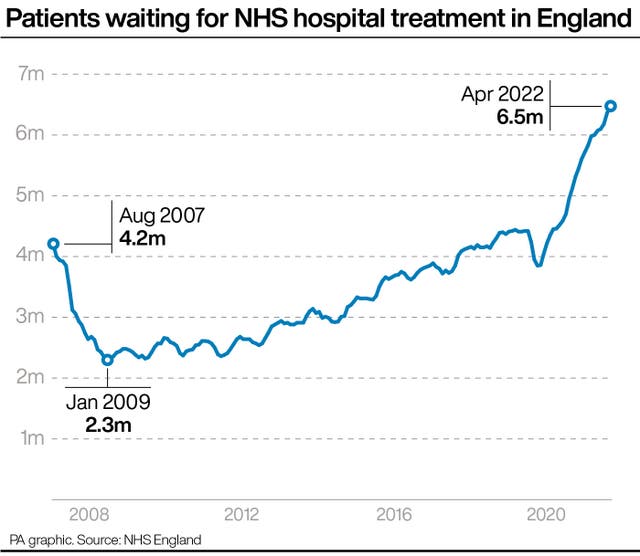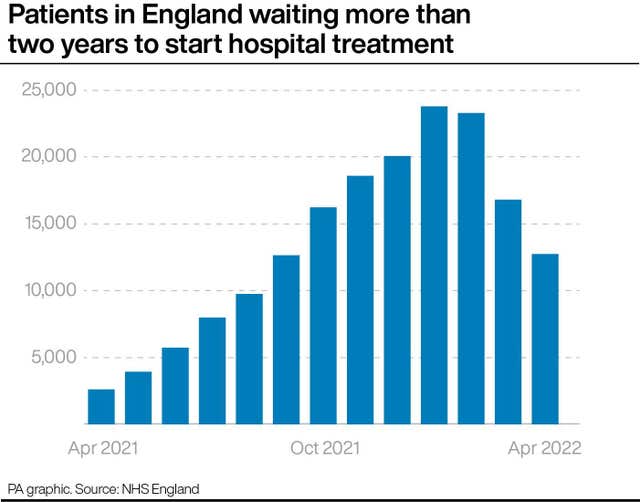Number of people waiting longer than two years for NHS treatment falls sharply
The overall NHS waiting list for England stands at 6.5 million people.

The number of people waiting longer than two years for NHS treatment has fallen sharply, though the overall waiting list is still rising, figures show.
New data from NHS England shows that two-year waits for treatment almost halved in a three-month period.
Some 12,735 people were waiting more than two years for hospital treatment at the end of April, down from 23,778 in January 2022 (the all-time high).
However, the latest figure is nearly five times the 2,608 people who were waiting longer than two years in April 2021.

The data also showed 323,093 people had been waiting at least a year for treatment in April, up from 306,286 the previous month.
The Government has set the ambition of eliminating all waits of more than a year by March 2025.
A total of 6.5 million people were waiting to start treatment at the end of April, up from 6.4 million in March. It is the highest number since records began in August 2007.
Tim Mitchell, consultant, ear, nose and throat surgeon and vice president of the Royal College of Surgeons of England, said: “Today’s figures show light at the end of the tunnel for people who have been waiting excessively long for a planned hospital treatment.
“Surgical teams have been working around the clock to reduce the enormous waiting list which built up during the pandemic.
“However, there are still big challenges ahead. As people return to the NHS, demand is only getting stronger.”
Thursday’s data further shows 204,818 urgent cancer referrals were made by GPs in England in April.
This is down from a record 253,796 referrals in March, but is higher than the equivalent figures for April 2020 at the start of the Covid-19 pandemic (80,031) and for the non-pandemic month of April 2019 (199,217).

Some 439,306 patients in April were also waiting longer than six weeks for one of 15 standard diagnostic tests, including an MRI scan, non-obstetric ultrasound or gastroscopy.
Elsewhere, the the average response times in May for ambulances in England have improved slightly.
This is down from nine minutes and two seconds in April, but is still above the target standard of seven minutes.
Ambulances in England also took an average of 39 minutes and 58 seconds last month to respond to emergency calls such as burns, epilepsy and strokes.
This is down from 51 minutes and 22 seconds in April, but above the target of 18 minutes.
“There is no doubt the NHS still faces pressures – including a renewed increase in Covid patients – and the latest figures show just how important community and social care are in helping people in hospital leave when they are fit to do so, not just because it is better for patients but because it helps free up precious NHS bed space.”
Nuffield Trust deputy director of research, Dr Sarah Scobie, said: “The health secretary yesterday claimed the pandemic was the root cause of the A&E crisis, but the Government can not hide solely behind Covid-19.
“In May, 40% of patients attending major A&E departments waited over four hours to be admitted, transferred or discharged. But in reality, this key target has not been met since July 2015, and the root causes can be traced back to over a decade ago.
“While the pandemic has made the situation worse, we are reaping the rewards of a long-term squeeze on staffing and space.
“The new normal and the long waits illustrated by these figures go far beyond an inconvenience and put patients at considerable risk.”

“These increasingly commonplace long waits for emergency care are not just frustrating; they are potentially dangerous.
“Long waits for care and delayed discharges from hospitals were a concern long before Covid.”





